
Cross-section of an amethyst stalactite (Rob Lavinsky)
In 2001, Robert Lavinsky was at a crossroads. He had just finished his PhD in Molecular Genetics at University of California San Diego. The obvious next steps in his career path were in academia or research. That had been the plan, after all. But since middle school, he’d been skipping class to run a secret business on the side. It had only gotten more and more lucrative as time wore on, and now he was weighing whether to dive into it full time. To put himself through grad school he had been dealing rocks and crystals.
No, not like Breaking Bad. Lavinsky was selling actual rocks and actual crystals.
As a child, Robert Lavinsky collected and traded rocks and minerals because he loved them, but he never thought he’d make it his life’s work.
“When I was a kid, I looked at how mineral dealers made a living, and it was a peripatetic (nomadic) life,” Lavinsky says. He remembers older men going from show to show every week, living out of their vans. “There just wasn’t enough money in minerals in the mid-80s for most people to make a good living. You made a living but not a great living.”
So, he continued his minerals hobby, but chose a career path in science. Then, when Lavinsky was in college, he started dealing minerals online before anybody else did. And that changed everything. It changed enough that when he got his PhD he decided to give minerals, “a few years,” as his full time gig. “If it doesn’t work out,” he remembers telling himself, “I’ll go get a job in biotech.” Now the industry has grown by orders of magnitude — at the highest end, pieces that used to sell for $10,000 are now selling for over a million. And Lavinsky and his company, The Arkenstone — which he named when he was 14 for the ultra-precious stone the dwarf monarch pursues in The Hobbit — are the reigning kings.
King of the Arkenstone
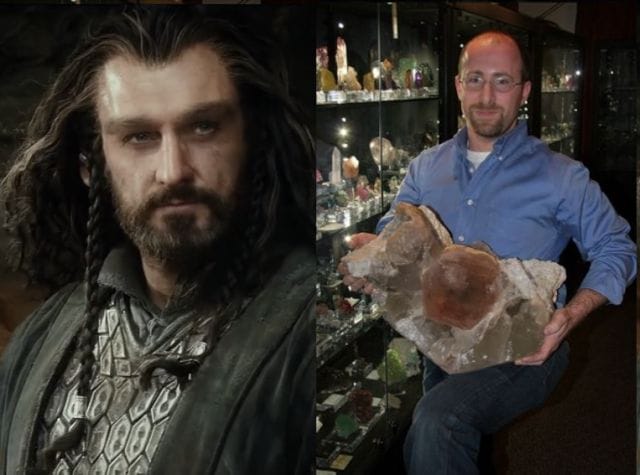
Left: Thorin Oakenshield, fictional Arkenstone hunter; Right: Robert Lavinsky, real world Arkenstone founder
“I never intended to be a mineral dealer,” Robert Lavinsky, now 42, tells us in an interview. “I thought: That would be stupid. Who would want to do that? That’s not even possible.”
To understand why Lavinsky felt that way, it helps to understand what mineral dealing is and what it’s not. For starters it is definitely not the jewelry business. Though many of the objects Lavinsky sells are sparkly rocks, most of them would never be practical on a necklace, and many of them aren’t made of precious materials. They’re specimens. They’re usually asymmetric and irregularly shaped, the crystals of the minerals are intact and uncut, just as they formed deep within in earth.
Lavinsky and his colleagues see their business as a kind of art collection. As Lavinsky says, “Each specimen is a work of art created by nature.” They’re valued more for their aesthetics (color, luminosity, shape, size, arrangement), and history (the mine of origin, the rarity of the form, the specimen’s previous owners), than they are for the value of their materials. Today, the right stibnite specimen, which is mined for tin, could easily be worth more than its weight in silver or gold.
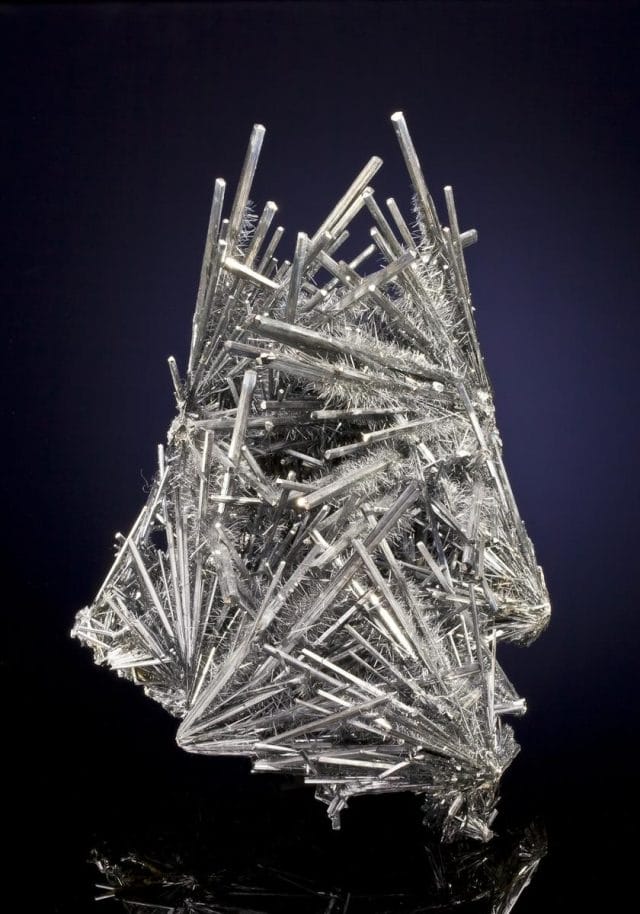
A stibnite specimen from China valued in the low six figures (courtesy of iRocks.com)
Although individuals have been collecting minerals like this for centuries, back in the 1980s, most mainstream mineral collectors were mostly scientists and casual hobbyists. When Lavinsky was a kid collecting sandstone fossils by the side of the road, his interest in rock collecting was “discovered” by the Columbus Rock and Minerals Society.
“You used to have these clubs all around the country,” Lavinsky remembers. “They were mostly made up of retirement age, old sense, old style rock collectors. They weren’t necessarily putting any emphasis on the value of these things. They collected them because they loved them.”
Lavinsky sold his first rocks at the rock show at the Columbus Ohio Veteran’s Memorial when he was 14. “I had my own table and my own specimens,” he said. “But I didn’t have a dealer’s license, and I couldn’t get one because I was too young.”
This is around when the young Lord of the Rings fan started calling his business ‘The Arkenstone.’ He laughs, “When you start your business when you’re 14, there’s a limited set of things you’re thinking about.”
He also worked for a local minerals collector and dealer, cleaning, cutting, and curating his stock, and going to shows. Once he got his driver’s license in high school, he started to go out into quarries to collect more rocks on his own. “Sometimes you’d have to bribe the people in the front gate at the quarry,” he says. “The older dealers would bring them a sixpack of beer. I would stop by Krogers and get a deli tray or a cheese tray, and show up at the quarry with a cheese tray for the secretaries and ask if I could go in and collect where the machines weren’t working.”
“Dealing, in one form or another, was the only summer job I ever had,” Lavinsky says. “And I kept it through college. Every summer I would just drive around the country in a circle, hitting up the different mineral and rock shows.”
But what he saw of the market tipped Lavinsky off that it was no kind of career. “I didn’t want to be a dealer,” Lavinsky says, “because I didn’t want to travel around the country weekend after weekend living out of trunk.” He went into science instead, and enrolled at Rice University to pursue a degree in biochemistry in the early 1990s.
“By sophomore year I needed a source of income to pay my tuition,” he says, “so mineral selling became my job. When I didn’t have money for something, I’d beef up the mineral selling.”
Minerals Go Digital
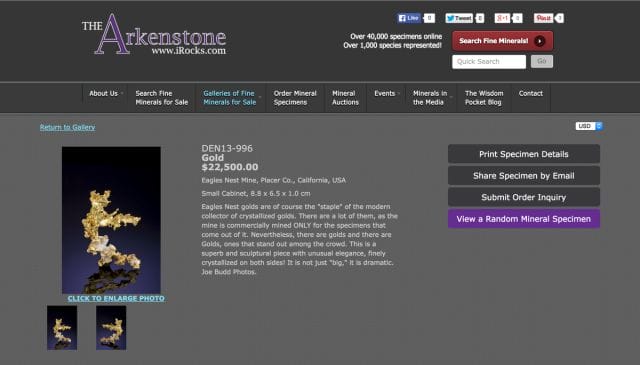
Screencap of the Arkenstone’s website, iRocks.com
In the early 1990s, Lavinsky’s dormitory at Rice University had a T1 connection and a computer lab. This gear made Lavinsky the highest-tech dealer in the game. “The average dealer was three times my age,” he reminds the author.
“People kept telling me I was wasting my time. They said, ‘No one will ever buy minerals on the Internet. It’s a kinetic, tangible thing.’ I said, ‘Ah, I’ve got time.’”
One of his biggest successes in this phase of his career was when a group of Russian academics visited Houston, managing a Faberge egg exhibit.
“I still knew Russian from high school and they didn’t know English,” Lavinsky remembers. “The Kremlin Museum and the Moscow University Museum had apparently sent them over with one-way-tickets and no money for food.” In order to make ends meet, the Russian curators set up a rickety card table outside the billion-dollar Faberge egg exhibit, and sold minerals their colleagues in Russia had smuggled out of the museum basement and mailed over.
“I’d buy 100 pieces at a time on my lunch break between classes,” Lavinsky says. “Then I’d get on email and sell them for double, triple, or quadruple the money within a day.” Selling online was so effective that Lavinsky started the first online minerals retail site in 1995. This was kind of a hockey stick moment for The Arkenstone.
“All of a sudden, it’s 2000,” Lavinsky says. “I’m in grad school, and I still intend to be a scientist, but my minerals business has been doubling every year since 1995.” This is when he really started to appreciate the sea change he had helped bring about. The market had grown. More people were buying minerals, and they were paying more for them. Lavinsky thinks the internet, and its price transparency, drove a lot of this: once people realized that fine minerals existed, and they could purchase them, they scrambled to do so. Publishing prices and educational information also helped stabilize and standardize the value of these items. Minerals became legitimate investments.
The result was that the industry — formerly dominated by scientists and hobbyists, so-called “rock hounds” — suddenly had a high end. A very high end, only getting higher. Today the best minerals specimens can sell for millions of dollars.
Just as importantly for Lavinsky, online retail meant that he wouldn’t have to travel to find buyers. He could do most of his business online, from home. So he did it. In 2001 he graduated, and went full time.
After that, business continued to grow. Lavinsky was one of the few dealers who was able “hack the business end and the financial end” and keep up with market growth. He says he is now among four or five dealers who control 50% of the market, and life at the top is good.
The Typical Minerals Collector is an Atypical Person
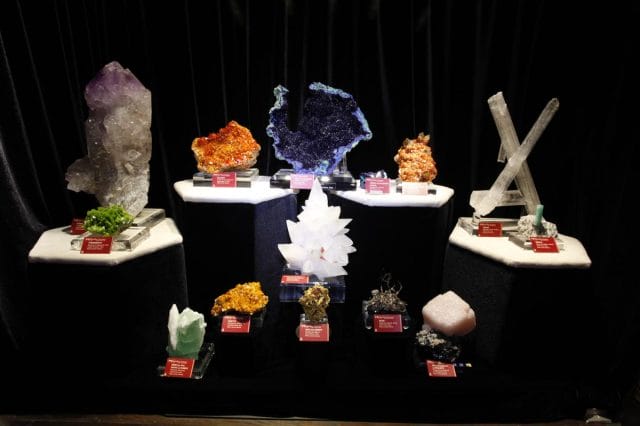
Selection from Lavinsky’s personal collection of Chinese minerals, on display at the University of Arizona (courtesy of iRocks.com)
“The scale of the economy has grown so much you can make a good living doing this — there are enough people buying pricier mineral specimens. It’s not just guys living out of their vans selling stuff in ballrooms in a Marriott anymore,” Lavinsky says with a gesture, adding, “although this is one of the nicer Marriott ballrooms.”
It’s a Friday evening at the Marriot Hotel in Emeryville, California. In a windowless room on the first floor, dozens of fine mineral specimens sit on folding tables, glittering under carefully-placed lamps. Lavinsky has taken a break from flitting around the room, inspecting each specimen, making sure it’s priced correctly, to be interviewed.
Lavinsky explains that this pop-up show is a relatively minor event in his business. The Arkenstone attends the annual, two week Tucson Gem & Mineral Show, which is one of the largest in the world. Then there’s the Munich Show, and the Denver Gem & Mineral Show, and the annual Dallas Symposium that The Arkenstone runs. And of course there’s the Arkenstone gallery in Dallas, which is one of the largest galleries of fine minerals in the world, and the company’s second gallery in Shanghai. And there are The Arkenstone’s online sales through their website, iRocks.com.
Lavinsky says he does private shows in small venues like this mostly to engage local mineral scenes. To help novices get their collections started, and to make room in his vaults for new inventory, he says there are plenty of times he sells pieces at or below cost.
A white-haired man beside him hears this and grunts sarcastically. “This is supposedly low range! If these prices are considered low,” the man, Stephen Smale, says, “that’s good for me! I like to see high prices! It means my collection is worth more.”
The show doesn’t officially start until the next day, but Smale is among the few community members who have been granted early access to the inventory.
It’s true that the prices are a little asynchronous with their humble surroundings. They’re roughly arranged by price. At the lower end, to the left, a two centimeter piece of something dark yellow called Legrandite is marked on the sale table as costing $2000. At the higher end, to the right, a ten-inch cluster of tiny sparkling chartreuse crystals — Pyromorphite — is marked at $12,000.
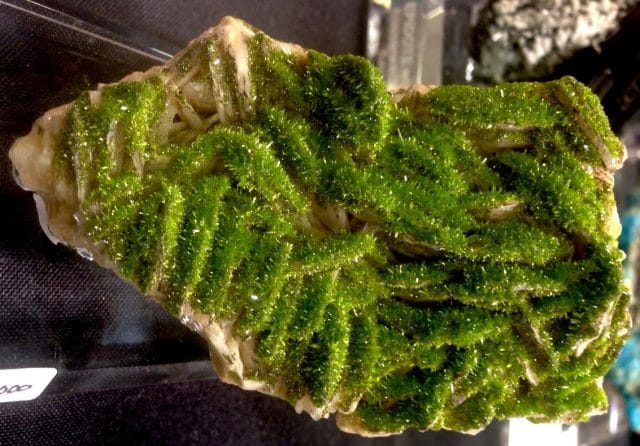
Pyromorphite specimen at the Arkenstone’s private show
“This is what I would call solid midrange market,” Lavinsky corrects him. “Solid, good things at what I would believe are fair prices for most collectors, OK? People who buy at around $1,000 to $10,000. People like Steve here buy at the next level.”
Smale is a high-end collector. He’s been collecting since the 1960’s and in that time he’s amassed one of the finest private mineral collections in the world. (As he tells it, “I got into it 45 years ago and spent all my money ever since on it.”)
In addition to being a collector, Smale is a Fields Medalist, and one of the most respected mathematicians in the world. In the 1990s he left his position at UC Berkeley for a professorship at the City University of Hong Kong. This was about the same time fine mineral extraction began to blossom in China, which meant the move was very good for his collection. “When miners in China find things, sometimes they bring them to me,” he says with a triumphant grin.
“Steve is a typical minerals collector,” Rob comments, “by which I mean he’s a highly atypical person.” Lavinsky attributes some of the mathematician’s sticker shock to the market’s history: “Steve has seen the whole cycle. It used to be you could buy the best mineral in the world for $10,000. Steve used to buy things in Brazil from miners who had no idea what they were worth. People like me made a worldwide market.”
Lavinsky is well known for his role in bringing mineral retail to the Internet, and driving prices up. “There are a lot of collectors out there that hate my guts,” Lavinsky adds. “They think they’re going to get priced out of a hobby. But that’s growing pains.”
A Very Special Crocoite
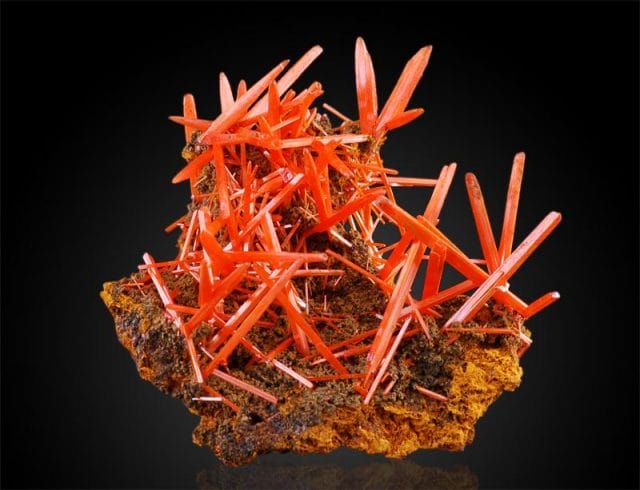
Crocoite specimen (courtesy of iRocks.com)
One good example of how online mineral retail transformed the market is sitting on a table right beside us. The spiky ball of long, thin orange crystals is not on sale. Lavinsky is delivering it to Smale from this year’s Tucson Gem & Minerals Show. Smale was stuck in Hong Kong, but knew this piece of crocoite would be there, so he had an associate purchase it and asked Lavinsky to transport it for him.
“A specimen this size,” Lavinsky explains, “Is worth 10 cents, 25 cents as lead. They would mine that out of Tasmania, toss it into carts and smelt it.”
Smale paid several thousands of dollars for his specimen, much more than he would have paid in the 1960s. Lavinsky admits that that’s probably partially his fault. “Nowadays, you can go to a jungle hut in Thailand or Burma and someone will come up with a Sony Vaio hooked up to a satellite phone and pull up my website,” Lavinsky says. “And they’ll say, ‘Rob Lavinsky is selling this for a thousand dollars a crystal, why are you offering me ten bucks?’”
But back then, that piece wouldn’t even have been saved from the smelter in the first place. Most collectible specimens come out of commercial mines, which focus on extracting raw materials. For unusually beautiful minerals to make it to market, the people who manage the extraction needs to know they’re valuable.
Online retail also attracts new collectors, which drives prices up on the demand side of things, too. “Some of the older guys are worried there’s a bubble,” Lavinsky says, “but there’s new people coming in every year. The prices reflect the demand.”
This means the economic incentives to mine gently are getting stronger and stronger, and more and more miners are aware of them. “The local community gets more money, we pay them more money,” Lavinsky says. “For the first time the fine minerals market has grown enough that there are places where they only mine for mineral specimens — not the raw materials.” The mine that pulled out the crocoite specimen is still operational as a fine minerals mine, and it produces lower-end pieces too.
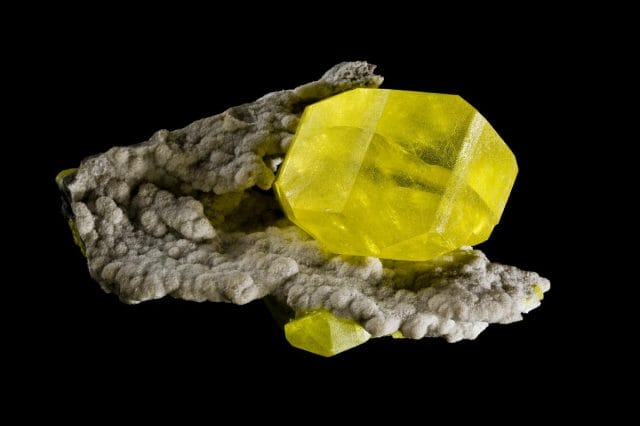
Sulfur specimen from Italy (courtesy of iRocks.com)
It’s pretty clear that the world of mineral extraction and mineral retail has changed considerably in the past 20 years. The market is big and getting bigger, and Lavinsky and other collectors predict that some day soon it will reach the same level as of other forms of fine art. “I don’t see a bubble,” Lavinsky says, “I see an emerging art class that’s going to have lots and lots of adherents.”
Lavinsky still travels quite a bit to stay at the top — between Tucson, Dallas, Denver, and Shanghai, not to mention local shows and international mines, he’ll go for long stretches of travelling every weekend. He says that being among the first to sell minerals online certainly helped his business, but The Arkenstone has maintained its lead because he and the team, “work our asses off.” But it’s apparent that he loves it. Even if he hadn’t decided to become a full time dealer, and went into biotech instead, it’s hard to imagine Robert Lavinsky would ever have stopped collecting minerals.
At some point during the interview, when asked why the market has grown as rapidly as it has, he attributes a lot of it to people realizing that they could own minerals in the first place. Because who wouldn’t want to?
“I can have these amazing, beautiful objects that are tens of millions of years old in my house!” he shouts. He certainly does.
This post was written by Rosie Cima; you can follow her on Twitter here. To get occasional notifications when we write blog posts, please sign up for our email list



